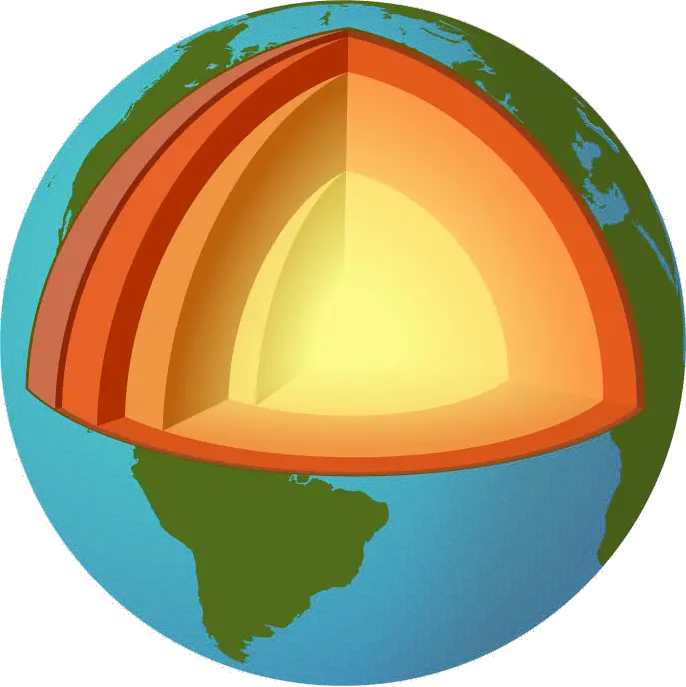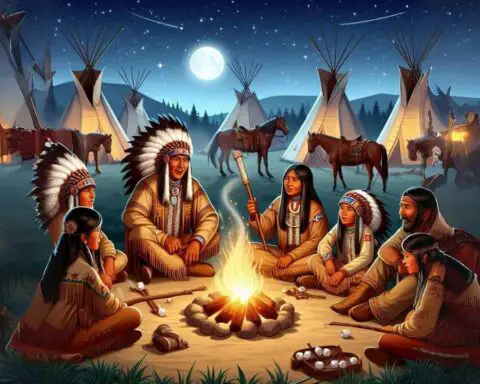Our planet Earth is composed of layers that can be classified rheologically and chemically. The study of these layers is important in geography at the school level and in geology at the college level. Here we have gathered a complete set of Layers Of The Earth Facts that will provide you a brief overview of all the layers. You are not going to learn about all the layers but also their composition, chemical properties, their importance, and many other interesting facts about Layers of Earth.
Layers Of The Earth Facts
What Are The Layers Of Earth – Structure Of The Earth
- The structure of Earth is composed of four major layers;
-
- The crust
- The mantle
- The outer core
- The inner core
- There is a unique physical state and chemical composition of each layer that can influence life on the surface of Earth.
- When geologists differentiate the Earth’s layers, they put subdivisions into two major categories;
-
- Rheologically OR
- Chemically

Layers Of Earth Based On Rheology
- Rheology is a branch of physics that deals with the study of matter’s deformation and flow, especially as a liquid state and as a soft solid state.
- Rheological differentiation means the liquid state of rocks under enormous temperature and pressure.
- Based on rheology, the layers of Earth are divided into;
- Lithosphere
- Asthenosphere
- Mesosphere
- Outer core
- Inner core

Layer Of Earth Based On Chemical Properties
- Based on chemical properties, the layers of Earth are differentiated into four layers:
-
- The crust
- The mantle
- The outer core
- The inner core
Facts About The Lithosphere
- The outer solid part of the Earth is known as the lithosphere.
- It makes the outermost layer of the structure of Earth.
- It consists of the crust and the upper brittle portion of the mantle.
- From above, the atmosphere bounds the lithosphere while from below the asthenosphere bounds it.
- The rocks of the lithosphere are not vicious but considered elastic.
- Below the lithosphere is the viscous asthenosphere.
- The boundary of both lithosphere and asthenosphere is the point where rheologists and geologists mark the ductility difference between the two layers.
- Ductility is the ability of a solid material to resist force or stress by changing its form rather than breaking.
- The lithosphere is much less ductile than the asthenosphere.
- There are two types of lithosphere:
-
- Continental lithosphere that is associated with continental crust
- Oceanic lithosphere is associated with oceanic crust
- Oceanic crust is denser than the continental crust and that is why floats lower in the mantle.
- The most popular activity of the lithosphere is tectonic activity, which means the movement and interaction of the huge slabs of lithosphere known as tectonic plates.
- The lithosphere is divided into many tectonic plates, such as Arabian, African, Indian, Australian, Pacific, Caribbean, Eurasian, Antarctic, North American, South American, Scotia, Philippine, Juan de Fuca, Nazca, and Cocos.
- Most of the tectonic activities occur at the boundary regions of these plates, where they may collide with each other, slide against each other, or tear apart from each other.
- Heat (thermal energy) from the mantle portion of the lithosphere makes the rocks of the lithosphere more elastic and makes the movement and interaction of the tectonic plates possible.
- The shape of the lithosphere is due to tectonic activity.
- Some of the geologic events on the Earth-like earthquakes, volcanoes, deep ocean trenches, and mountain building (orogeny) are due to the tectonic activity in the lithosphere.
- The lithosphere interacts with other spheres (biosphere, cryosphere, hydrosphere, and atmosphere) and shapes the environment of Earth.
Facts About The Asthenosphere
- The asthenosphere is a highly viscous portion of the Earth’s upper mantle.
- This layer lies just below the lithosphere, at the depth of approximately between 50 and 120 miles (80 and 200 km). While in some regions, its depth could extend approximately 430 miles (700 km).
- The asthenosphere is a mechanically weak and ductile region.
- This layer is almost solid, however, could be molten in some regions, such as at the mid-ocean ridges.
- The thickness of this layer mainly depends on temperature, however, the rate of deformation is also a factor that is involved in its rheology.
- The asthenosphere is involved in the tectonic activity and the adjustment of isostasy (gravitational equilibrium state between Earth’s crust and mantle).
- The temperature of the lithosphere-asthenosphere boundary (usually known as LAB) is taken conventionally at the isotherm of 1300 ℃.
- Below this temperature (near to the Earth’s surface) the mantle acts rigidly, while above this temperature (deeper below the Earth’s surface) the mantle behaves in a ductile way.
What Are The Layers Of The Earth Made Of
The following is the composition of the major layers of the Earth:
The Crust
- The dense oceanic crust is made up of iron and magnesium-rich silicate igneous rocks (also known as mafic), such as basalt.
- The less-dense, thicker continental crust is made up of silicate rocks rich in sodium, potassium, and aluminum (also known as felsic), such as granite.
The Mantle
- The mantle layer is made up of silicate rocks rich in iron and magnesium.
The Core
- The core region is believed to be primarily made up of iron and some nickel.

Elements In Each Layer Of The Earth
The chemical composition of all the major layers of the Earth is shown in the following tables:
The Earth’s Crust
| Most Abundant Elements on the Crust | Approximate Percentage by Weight | Oxides | Approximate Percentage |
| Oxygen | 46.6% | SiO₂ | 60.6% |
| Silicon | 27.7% | Al₂O₃ | 15.9% |
| Aluminum | 8.1% | CaO | 6.4% |
| Iron | 5.0% | MgO | 4.7% |
| Calcium | 3.6% | Na₂O | 3.1% |
| Sodium | 2.8% | Fe (as FeO) | 6.7% |
| Potassium | 2.6% | K₂O | 1.8% |
| Magnesium | 1.5% | TiO₂ | 0.7% |
| P₂O₅ | 0.1% |
The Mantle
- The most abundant elements in the mantle are silicon, iron, and magnesium.
- The following is the chemical composition of the upper mantle. It is believed that the rest of the mantle would also have the same composition.
| Compound | Percentage by Weight |
| SiO₂ | 44.71% |
| Al₂O₃ | 3.98% |
| FeO | 8.18% |
| MnO | 0.13% |
| MgO | 38.73% |
| CaO | 3.17% |
| Na₂O | 0.13% |
| Cr₂O₃ | 0.57% |
| TiO₂ | 0.13% |
| NiO | 0.24% |
| K₂O | 0.006% |
| P₂O₅ | 0.019% |
The Core
- It is believed that the primary element in both the outer and inner core regions is iron and some nickel, in the form of iron-nickel-alloy (Fe-Ni).
Why Are The Earth’s Layers Important
The Earth’s layers are important because:
- Continents on the Earth formed due to the movement of these layers. Around 250 million years ago, most of the Earth’s landmass was joined together in the form of a supercontinent known as Pangaea. Due to the tectonic activity, continental drift (gradual movement and formation of continents) occurred through the years and the seven continents were formed. The average movement rate of the continents is 2cm per year.
- The crust layer is broken up into many huge slabs known as the tectonic plates, which floats on the mantle. The tectonic plates usually slide smoothly, but sometimes these plates may collide or stick and build up pressure and then tear apart. These activities are known as tectonic activities, and when this happens, the events of earthquakes, volcanoes, mountain building, and deep ocean trenches occur.
- Earthquakes can be important because, during earthquakes, seismic energy is released that provides much information about the interior of the Earth. It also provides help to understand if the volcanoes are becoming less or more active.
- In some regions of the tectonic plates, volcanic hot spots are found. A volcanic hot spot is a region in the upper mantle where heat rises in the form of plumes from the deep of the Earth. At the base of the mantle, low pressure and high temperature facilitate the melting process of the rocks. The melted rocks, called magma, sometimes push upward through the cracks in the crust and erupt on the Earth’s surface in the form of volcanoes. The Hawaiian Islands were formed because of such a volcanic activity or a volcanic hot spot in the middle of the Pacific plate.

Information About Crust, Mantle, And Core
Crust
- The crust is the outermost layer of the Earth.
- Its depth ranges from 3.1 to 43.5 miles (5 to 70 km).
- The Earth’s crust is divided into two types. That is:
-
- The oceanic crust
- The continental crust
- The oceanic crust is the thin and dense part of the Earth’s crust situated under the ocean basin. Its depth is from 5 to 10 km. It is composed of silicate igneous rocks rich in iron and magnesium (known as mafic), such as basalt, gabbro, and diabase.
- The continental crust is the less dense and thicker part of the Earth’s crust. It is composed of silicate rocks rich in sodium, potassium, and aluminum (also known as felsic), like granite.
- The rocks of the crust layer are of two major types. That is:
-
- Sial, which are rocks rich in silicate and aluminum minerals and makes the upper layer of the Earth’s crust.
- Sima is a rock rich in silicate and magnesium minerals and makes the lower layer of the Earth’s crust.
Mantle
- The mantle layer lies between the crust and the outer core.
- It is a predominantly solid layer of silicate rocks, however, it is believed that it behaves as a viscous fluid in geological time. The mantle is approximately 2,900 km (1,800 miles) thick.
- It makes up approximately 84% of the total Earth’s volume.
- in the mantle, the pressure and temperature increase with the depth. The temperature near its boundary with the crust is up to 1000 °C (1832 °F) and up to 3,700 °C (6,692 °F) near its boundary with the core. The geothermal gradient in most places is 25 °C per km of depth.
- The viscosity of the Earth’s mantle also varies greatly. Its upper part is mostly solid, but its viscosity decreases at the boundaries of tectonic plates and mantle plumes.
- Rheologically, Earth’s upper mantle is divided into two major layers;
-
- Lithosphere that is rigid and comprises the uppermost mantle
- Viscous asthenosphere.
- The lithosphere-asthenosphere boundary (LAB) separates both layers.
- The thickness of the lithosphere under the oceanic crust is about 100 km while its thickness underlying the continental crust is from 150 to 200 km.
- The lithosphere along with the overlying crust make up tectonic plates that ‘float’ or move over the asthenosphere.
- Based on sudden changes in seismic velocity, Earth’s mantle is divided into the following layers:
- The Upper Mantle is a mostly solid region of the Earth’s mantle. However, there are also more malleable regions in the upper mantle that contribute to tectonic activity. It extends to the depth of about 410 km (255 miles) from the Earth’s crust. The lithosphere and asthenosphere are the two parts of the upper mantle.
- The Transition Zone exists between the upper and the lower mantle. It starts at the end of the upper mantle at the depth of about 410 km and extends downward to the depth of 660 km. In the transition zone, rocks undergo radical transformations and their crystalline structure changes in many important ways. Such changes cause the rocks to become much denser. In the transition zone, water exists abundantly in the form of hydroxides.
- The Lower Mantle starts at the end of the transition zone at the depth of about 660 km and extends downward to 2,891 km. As compared to the upper mantle and transition zone, this layer is much hotter and denser (due to intense pressure).
- The D” (D-double-prime) is about ~200 km region of the lower mantle at its boundary with the outer core. In some regions, it is extremely thin, whereas, in other regions, it has thick iron and silicates accumulations. In some regions, huge melts have been detected. This region has anomalous seismic properties.
Core
- The core is an extremely dense and extremely hot center of our planet Earth.
- It is at the depth of 2,900 km (1,802 miles) below the Earth’s surface.
- The radius of the core is about 3,485 km (2,165 miles).
- Earth’s core is considered as the furnace of geothermal gradient, which means a measure of the gradual change in temperature from Earth’s core to its crust.
- The value of the geothermal gradient is approximately 25 °C per km (1 °F per 70 feet).
- The primary heat sources in the core are; decay of radioactive elements, remaining heat from planetary formation, and the heat released in the solidification process of the liquid outer core near its boundary with the inner core.
- The core layer of Earth is almost entirely made up of metal, especially, iron and nickel.
- Other elements found in the Earth’s core are siderophiles (the elements that dissolve in iron). Many of these elements are also known as precious metals because they are rare on the Earth’s crust. Examples of sideophiles include platinum, gold, and cobalt.
- Sulphur is another key element found in the Earth’s core. About 90% of the total sulphur on the Earth is found in the core.
- The core is the hottest part of the Earth, however, it is difficult to determine the exact temperature of this region. The temperature of the core fluctuates due to pressure, the varying composition of the elements, and the Earth’s rotation. The general temperature range is from approximately 4,400 °C (7,952 °F) to approximately 6,000 °C (10,800 °F).
- The core is divided into two layers: the outer core (that borders the mantle) and the inner core. A boundary separates both the layers, which is known as the Bullen discontinuity.
Interesting Facts About The Earth’s Crust
- The known oldest mineral grains of the Earth’s crust were approximately 4.4 billion years old, which indicates that the solid crust of Earth is at least 4.4 billion years old.
- Plates of the Earth’s crust are constantly moving. According to NASA, the rate of their motion and the rate of the growth of fingernails is about the same.
- Both types of the Earth’s crust; the oceanic and the continental, float on the mantle. Because of higher density, the oceanic crust floats lower than the continental crust and that is why water pools above this crust and forms oceans.
- The Hawaiian Islands came into being because of volcanic activity in the Pacific plate of the Earth’s crust.

Facts About The Earth’s Mantle
- The mantle is the thickest of all the Earth’s layers.
- The mass of mantle is 4.01 ✕ 10²⁴, which makes up 67% of the total mass of the Earth.
- At the mid-ocean ridges, the partial melting of mantle produces oceanic crust, while at the subduction zones, its partial melting produces continental crust.
- The transition zone of the Earth’s mantle is extremely dense and prevents material exchanges between the upper and lower mantle.
- In the transition zone, crystals hold water in the form of hydroxides, the amount of which is as much as all the oceans on the Earth’s surface.
What State Is The Mantle
- The mantle is predominantly solid.
- However, its viscosity decreases at the boundaries of tectonic plates and mantle plumes.
- It is believed that this layer of Earth behaves as a viscous fluid in geological time.
How Thick Is The Mantle
- Mantle is 2,900 km (1,800 miles) thick.
- It is the most thicker layer of the Earth and makes up approximately 84% of the total Earth’s volume.
Facts About The Earth’s Outer Core
- The outer core of Earth is a liquid layer that underlies the mantle and above the inner core.
- The thickness of this layer is approximately 2,400 km (1,500 miles) and is made up of mostly iron and some nickel.
- The outer boundary of the outer core lies at the depth of 2,890 km (1,800 miles) beneath the surface of the Earth.
- The temperature range of the outer core near the mantle (its outer region) is estimated as 2,730 to 4,230 °C (4,940 to 7,640 °F), while of its lower region (near the inner core) is estimated as 3,730 to 7,730 °C (6,740 to 13,940 °F).
How Thick Is The Outer Core
- The Earth’s outer core is approximately 2,400 km (1,500 miles) thick.
Facts About The Earth’s Inner Core
- Earth’s inner core is a hot and dense innermost layer of the Earth.
- It is a solid ball mostly composed of iron.
- Its radius is about 1,220 km (760 miles), which is about 20% of the total radius of the Earth.
- The estimated temperature at the surface of the inner core is 5,430 °C (9,806 °F).
What Is The State Of Matter Of The Inner Core
- The state of matter of the inner core is primarily solid.
What Is The Thinnest Layer Of The Earth
- The thinnest layer of the Earth is the Earth’s crust.
- The depth range of this layer is 5 to 70 km (3.1 to 43.5 miles).
Which Layer Of The Earth Is The Hottest
- The hottest layer of the Earth is the core.
- Its temperature ranges from about 4,400 °C (7,952 °F) to about 6,000 °C (10,800 °F).
- Bullen discontinuity is the hottest region of the core, where the temperature reaches 6,000 °C, which is about the same temperature as that of the Sun’s surface.











